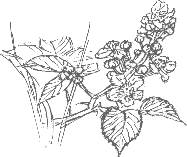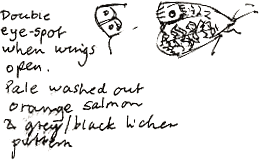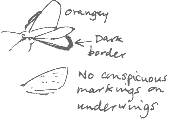 |
Bramble PatchFriday, 12th July 2002, West Yorkshire |
![]()
![]()
![]()
![]() Rocks |
History |
Workshop |
Links |
Home Page
Rocks |
History |
Workshop |
Links |
Home Page
![]()
 When I used to walk across Storrs Hill, between Ossett and Horbury, West Yorkshire, on my way to school almost forty years ago the hollow below the quarry was uniformly grassy. Over the years a dense bramble patch has developed at the south-facing bank of the hollow, nearest the rock face. As you can imagine, it is a magnet for insects on a glorious summer day like today.
When I used to walk across Storrs Hill, between Ossett and Horbury, West Yorkshire, on my way to school almost forty years ago the hollow below the quarry was uniformly grassy. Over the years a dense bramble patch has developed at the south-facing bank of the hollow, nearest the rock face. As you can imagine, it is a magnet for insects on a glorious summer day like today.
 There are many microspecies of bramble. Despite all those blooms and the pollinators that they attract, the plant is often self fertile, in which case the offspring are clones. This particular bramble has white flowers. The hairless stems, which are green to wine red, are armed with backward facing spines.
There are many microspecies of bramble. Despite all those blooms and the pollinators that they attract, the plant is often self fertile, in which case the offspring are clones. This particular bramble has white flowers. The hairless stems, which are green to wine red, are armed with backward facing spines.
Grayling
 A butterfly comes and feeds from the blossoms as I sketch. Unfortunately it doesn't open its wings but I get a chance to sketch the undersides in some detail. As I've noted on my sketch, the underside of the wings have a grey/black lichen pattern and a double eyespot on the underside of the forewing that is visible when the wings open. As it feeds, only one of these eyespots shows the other is covered by the hindwing. The spots are on a washed out orange/salmon background.
A butterfly comes and feeds from the blossoms as I sketch. Unfortunately it doesn't open its wings but I get a chance to sketch the undersides in some detail. As I've noted on my sketch, the underside of the wings have a grey/black lichen pattern and a double eyespot on the underside of the forewing that is visible when the wings open. As it feeds, only one of these eyespots shows the other is covered by the hindwing. The spots are on a washed out orange/salmon background.
I'm glad I sketched it in detail because otherwise I'd be wondering if I'd really seen some of these details. Thomas and Lewington's Butterflies of Britain and Ireland describes the Grayling as 'locally common on dry coastal dunes and southern lowland heaths' and they say it is 'rare and declining elsewhere in its range.'
Butterflies can turn up anywhere but when I read the description of the grayling's habitat requirements I begin to think that we might have a colony here on the hill;
'The grayling, more than any of our butterflies, is confined to dry, dusty, places where the soil is poor and thin, the vegetation sparse, and the terrain so rutted or broken that the sun's rays bake the ground . . . but I have found Graylings on much smaller sites, such as abandoned quarries ...'
Thanks to the pushbike and motorbike scramblers who occasionally use the hill that's exactly what we've got here. I've often been annoyed by motorbike noise in wild places but I would never have guessed that those pesky scramblers might have made a contribution towards butterfly conservation. Bless 'em.
 If I'm right in my identification, this is a female. Her lower eyespot is bigger than the male's. To tell you the truth, I had been watching brown butterflies flying around the bramble patch but I had assumed that they were all meadow browns.
If I'm right in my identification, this is a female. Her lower eyespot is bigger than the male's. To tell you the truth, I had been watching brown butterflies flying around the bramble patch but I had assumed that they were all meadow browns.
Note: Not surprisingly, when I reported my record of Grayling to members of the Wakefield Naturalists' at first they didn't believe me; 'It'll be a Gatekeeper, some of them can look like graylings'. But the Peter Smith, the Research Officer, Philip Harrison, the Secretary and Dorothy Walls, former Treasurer, turned up on Monday 12 August when I was drawing on Storrs Hill to check out my record. Sure enough, they found Graylings where I'd reported them but also found them elsewhere on the hill. As at that time the only known colony of Grayling in Yorkshire was in a secret location on the Wolds, they asked me to withdraw my record from this online diary.
They made a survey of the area and discovered a larger colony of Grayling on former railway tracks around Healey Mills Marshalling Yards south-west of Storrs Hill. As that colony was featured in the BBC's Natural World film Butterflies: A Very British Obsession, on 17 December 2010, I feel that I can now reinsert my original record in my online nature diary.
We passed the information on to the Biodiversity Committee, Natural England and the county Butterfly recorder who all kept the information so secret that the guy who lives in Rock House who was doing some landscaping work a year or two later bulldozed the plateau, which is where I suspect the caterpillar's food plant, a weedy little grass (Sheep's fescue or a Bent grass?) grew!
Small Skipper

 I see three different species of hunting wasp; the most spectacular is this yellow and black one which is a couple of centimetres, about three-quarters of an inch, long. It waves it's antennae as it hunts around the edge of the bramble patch and amongst the grasses nearby.
I see three different species of hunting wasp; the most spectacular is this yellow and black one which is a couple of centimetres, about three-quarters of an inch, long. It waves it's antennae as it hunts around the edge of the bramble patch and amongst the grasses nearby.
![]()
Richard Bell,
wildlife illustrator
E-mail; 'richard@willowisland.co.uk'
![]() Next page |
Previous page |
This day in 2000 |
This month
Nature Diary |
Home Page
Next page |
Previous page |
This day in 2000 |
This month
Nature Diary |
Home Page
![]()